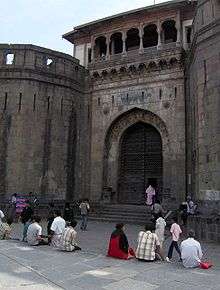Rainbow BRTS
 | |
| Overview | |
|---|---|
| Owner | PMPML |
| Locale | Pune, India |
| Transit type | Bus Rapid Transit |
| Number of lines | 6 |
| Number of stations | 102 |
| Website | http://rainbowbrt.in/ |
| Operation | |
| Began operation | 2006 |
| Technical | |
| System length | 61 km (38 mi) |
Rainbow BRTS is a Bus Rapid Transit System in the twin cities of Pune and Pimpri-Chinchwad, in Maharashtra, India. The system is operated by the Pune Mahanagar Parivahan Mahamandal Limited (PMPML). The infrastructure has been developed by the Pune Municipal Corporation (PMC), Pimpri-Chinchwad Municipal Corporation (PCMC). The project currently envisages 113 km of dedicated bus corridors along with buses, bus stations, terminals and intelligent transit management system.
The Rainbow BRTS project is being implemented with the financial support of Jawaharlal Nehru National Urban Renewal Mission (JnNURM) of the Government of India. Additionally, specific components of the project in Pimpri-Chinchwad are being funded under the ‘Sustainable Urban Transport Project’, which is an initiative of the Ministry of Urban Development, Government of India and is supported by The World Bank, UNDP & GEF.[1]
History
Pune was the first city in India to experiment with a Bus Rapid Transit system. PMPML started plying pilot routes in December 2006. The Hadapsar-Katraj pilot project consisted of 16.5 kilometres (10.3 mi) of bus lanes along the Pune Satara Road using airconditioned, low-floor more than 500 Volvo B7RLE buses initially on Katraj - Swargate - Hadapsar. Most of these buses are not in service currently. The funding for the project came from the Government of India under the Jawaharlala Nehru National Urban Renewal Mission. Total of 112 kilometres (70 mi) route was proposed for Pune BRTS. Now regular PMPML buses ply on the Hadapsar-Katraj corridor of BRTS.
The Pimpri-Chinchwad BRTS was announced in December 2008, when eight routes covering 112 km were proposed. Construction of the first route was due to be completed within 18 months.[2] By January 2009, 90% of construction work on an 11 km pilot route between Nigdi and Dapodi had been completed. However, a string of disputes between the Pimpri-Chinchwad Municipal Corporation (PCMC), civic administrators and corporators led to the project being delayed, with corporators citing funding difficulties and problems encountered on the similar Delhi BRTS and Pune BRTS projects as the causes.[3]
In September 2009 it was announced to the press that, although most work had been completed, difficulties procuring the 650 buses required to run on the system had led to the project being indefinitely postponed. It was also found that the proposed new bus shelters had been due to be installed on the wrong side of the road, leading to delays in their construction, while passenger information systems had yet to be installed. The PCMC stated that this was not a major issue as the shelters could be constructed quickly from prefabricated materials, and that the vehicles would be purchased by December 2009.[4] A month later it was revealed that the cost of the project had overrun by 230 crore, around 50% of the total project cost.[5] By May 2010, funding for the completion of four BRT routes had been agreed, with the remaining four sanctioned by the national government but not yet funded. A number of high-rise buildings along the routes had also been approved for construction.[6]
Both the systems were merged to form Rainbow BRTS which is currently under expansion.
By April 2014 two of the routes were under construction, with the first station near to completion.[7] The first two lines were expected to be operational by the end of March or the beginning of April 2015.[8] The Sangvi-Kiwale corridor (earlier named as Aundh-Ravet corridor) was thrown open to public on 5 September 2015.[9]
Description

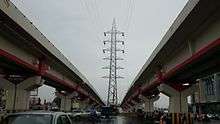
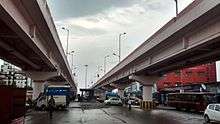
The Rainbow BRT system in Pune and Pimpri Chinchwad, launched in 2015, has features such as:
- Special Rainbow BRT buses with doors on both sides that run in reserved lanes in the BRT corridors
- Bus stations that are covered, closed and located in the median of the dedicated lanes, with access ramps and signage
- Level Boarding - The bus platform and the BRT station platform are at the same height
- Automatic Doors - Automatic doors on BRT stations and bus doors open when the bus is correctly docked at the station
- Crossings - The crossings from the footpath to the BRT stations have signals at several locations or have speed tables
- Passenger Information System - Information on bus arrivals is displayed on screens at the bus stations. Buses have display screens and audio announcements. Route numbers are displayed on LED screens on the front, back and the left side of buses
- Intelligent Transit Management System - The BRT Buses have GPS and buses and stations are linked with a BRTS Control Room which tracks bus movement and is able to communicate with the bus drivers.
- Security and Traffic Management- Security personnel are deployed at the bus stations. Traffic Wardens are deployed at signals and crossings to prevent entry of other vehicles (apart from BRT buses and emergency vehicles) into dedicated bus lanes.
Feeder bus routes or regular services are run by PMPML from various locations in the city up to the BRT corridors.
The system will when completed comprise eight routes with a total length of 112 km, with improved street lighting and passenger facilities on the roads used by the system.[2] It will require around 650 buses to operate the complete network.[4] The system will be substantially different from that in neighbouring Pune, with wider roads and grade separation allowing a more substantial network to be constructed.[10]
The buses and bus stops alike are integrated via the Integrated Traffic Management System (ITMS) which enable travellers to know the ETA of the bus. The bus stops and the buses are equipped with automatic doors, that open when they are in close proximity. The bus-stops are easily accessible by a low-gradient ramp on one end. Signals are being installed near the bus stops to enable pedestrians to cross the road.
Features
The features of Rainbow BRT include
- Buses - Over 600 special Rainbow BRT buses with doors on both sides and more standing space, that ply smoothly and rapidly in reserved lanes
- Bus stations in the BRT Lanes - Covered and provide protection from rain and sun, well lit, have a ramp at the entrance and signage boards with information about the BRT corridors
- Tickets at stations - The ticket is to be bought at the ticket counter inside the station before boarding the bus. Smart Cards are proposed in the next phase.(Alternate option of buying from bus conductor is also available.)
- Level Boarding - The height of the bus platform and the BRT station platform are at the Doors and Bus Interface same level. Passengers do not have to climb steps to board the bus, a feature similar to metro rail.
- Automatic Doors - Automatic doors on BRT stations and bus doors open only when the bus is properly docked at the station
- Crossings - The crossings from the footpath to the BRT stations have signals in many locations or have speed tables so that vehicles have to slow down to allow passengers to cross safely.
- Bus Numbers, Bus Arrival and Station Information - Information on bus arrivals is displayed on screens at the bus stations. Display screens and audio announcements in buses give information about the next stop. Route numbers appear on LED displays on the front, back and the left side of buses
- Intelligent Transit Management System - BRT Buses have GPS and all buses and stations are linked with the BRTS Control Room at Swargate which tracks bus movement and gives feedback to drivers to improve service.
- Security and Traffic Management - Security personnel are present at each BRT bus station. Traffic Wardens are present at signals and crossings to help in the management of other traffic and prevent entry into dedicated bus lanes.
Routes

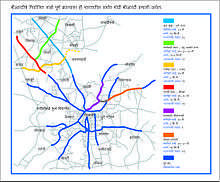
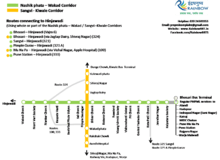
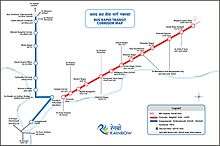
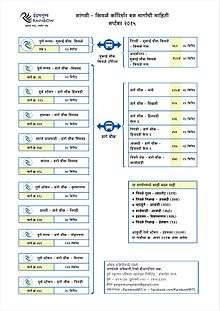
Completed
- Katraj - Swargate - Hadapsar. (Via Pune-Satara road, Shankarsheth road via Swargate Bus Station - 16.5 km)
- Vishrantwadi - Bombay sappers - Yerwada - Waholi Jakat Naka and Sadalbaba Jn - Patil Estate. (Total = 16 km)
Under Construction
- Warje - Kharadi corridor. PMC has taken a lot of efforts to make this one a successful project. The pattern of the bus stops is different than Satara road bus stops. This pattern of bus stops does not create sharp turns on the other lanes like the Satara road BRTS does.
Other Proposed Corridors
- Katraj - Kalewadi Phata corridor.
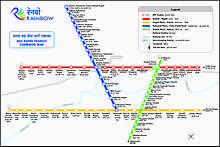 BRTS Route Map for Pimpri Chinchwad
BRTS Route Map for Pimpri Chinchwad - Kothrud - Vishrantwadi corridor.
- Dhayari - Hadapsar Gadital corridor.[11]
Other Proposed Roads
- Baner Road.
- F. C. Road (Officially named as Gokhle road).
- J. M. Road.
- Karve Road.
- Paud Road.
- Sinhgad Road.
- University Road.
- Samgamwadi Road.
- Dhanori Road.
- Nehru Road.
- Mundhwa Bypass.
- Nagar Road.
- Airport Road.
- Yerawada - Vishrantwadi Road.
- Solapur Road.
- Ramwadi - Viman Nagar Road.
- Vishrantwadi - Viman Nagar Road.
- Vishrantwadi - Dhanori Road.
- Deccan College - Viman Nagar Road
Repair work
In 2012, the PMC started to make changes on the road so that the management of traffic would become easier. A 1.5 km long flyover is being constructed from Padmavati to Bhartividyapeeth, which will have 4 lanes, plus the existing 4 lanes. The legs of the flyover are constructed on the BRTS route. The BRTS has been cancelled. Apart from the flyover, there are 2 subways being constructed at Bibwewadi chowk and Kaka Halwai chowk for the pedestrians to cross. These three constructions will reduce a lot of time to travel through this route.
Phases
Pilot Phase
A pilot system was constructed on the Katraj - Swargate - Hadapsar corridor and operations began in December 2006. At a time when 'BRT' acronym was new to India and there was limited nationwide understanding of requirements for such an advanced public transport system, Pune was the first city in India to implement and operationalise a high capacity bus system on two corridors:
- Swargate–Hadapsar (East‐West Corridor) – 10.2 km
- Swargate–Katraj (North‐South Corridor) – 5.8 km
The infrastructure and operations was an improvement over the regular bus services while many features which are intrinsic to a Bus Rapid Transit System were not a part of it. The infrastructure components included widening of roads, construction of footpaths and cycle tracks, laying of municipal services like water supply and drainage lines, utility ducts, construction of BRT lane‐segregators, bus stops, installation of Passenger Information System, etc. The Ministry of Urban Development, Government of India provided financial support for the project.
However, with the construction of 3 flyovers along the route, the pilot corridor has now been interrupted at various points and the use of the dedicated lane discontinued.
Phase 1
Six corridors are being developed in the current phase of the Rainbow BRTS network.
| Corridor Name | Length (km) | Number of Stations | Region | Status |
|---|---|---|---|---|
| Nagar Road | 8 | 13 | Pune | Oprerational from April 2016 |
| Sangamwadi - Vishrantwadi | 8 | 9 | Pune | Operational from August 2015 |
| (NH4) Old Mumbai - Pune Road | 12 | 36 | Pimpri Chinchwad | Under construction |
| Sangvi Phata - Kiwale | 14 | 21 | Pimpri Chinchwad | Operational from September 2015 |
| Nashik Phata - Wakad | 8 | 15 | Pimpri Chinchwad | Operational from November 2015 |
| Kalewadi Phata - Dehu Alandi Road | 11 | 20 | Pimpri Chinchwad | Under construction |
See also
References
- ↑ iMC. "BRT". www.pmpml.org. Retrieved 2015-09-08.
- 1 2 Tarun Nangia, Pune (21 Dec 2008). "Pimpri-Chinchwad BRTS to give route map a new glow". Indian Express. Retrieved 2013-04-21.
- ↑ "Pimpri-Chinchwad Municipal Corporation advised to go slow on BRTS plan". Institute for Transportation and Development Policy. 15 January 2009. Retrieved 2013-04-21.
- 1 2 Rapid transit system on slow track - Pune - The Times Of India
- ↑ PM News Bureau (12 October 2009). "Pimpri-Chinchwad BRTS cost overrun". Projects Monitor. Retrieved 2013-04-21.
- ↑ Soon, high-rise buildings for Pimpri-Chinchwad Indian Express
- ↑ Steady Progress on the Pune-Pimpri-Chinchwad BRT
- ↑ PCMC to start BRT service next year
- ↑ http://indianexpress.com/article/cities/pune/costliest-brts-rolls-out-in-pimpri/
- ↑ BRTS in Pune different from Pimpri-Chinchwad's - Pune - News | News Syndication
- ↑ Pune BRTS
Map_Corridors.pdf
RainbowBrtPune
External links
- Rainbow BRTS
- BRTS finally flagged off
- Sangamwadi-Vishrantwadi Route to become operational today
- BRTS pilot to run on Sunday
- Pune becomes first city in India to have BRT system
- From the bus to tickets, BRT's first run finds many fans
- On day three, a smooth ride for BRTS
- BRTS work on other roads begins
- Pune's BRT stumbles at the start
- Link to Bus Rapid Transit Newsletter for Jan 2007
